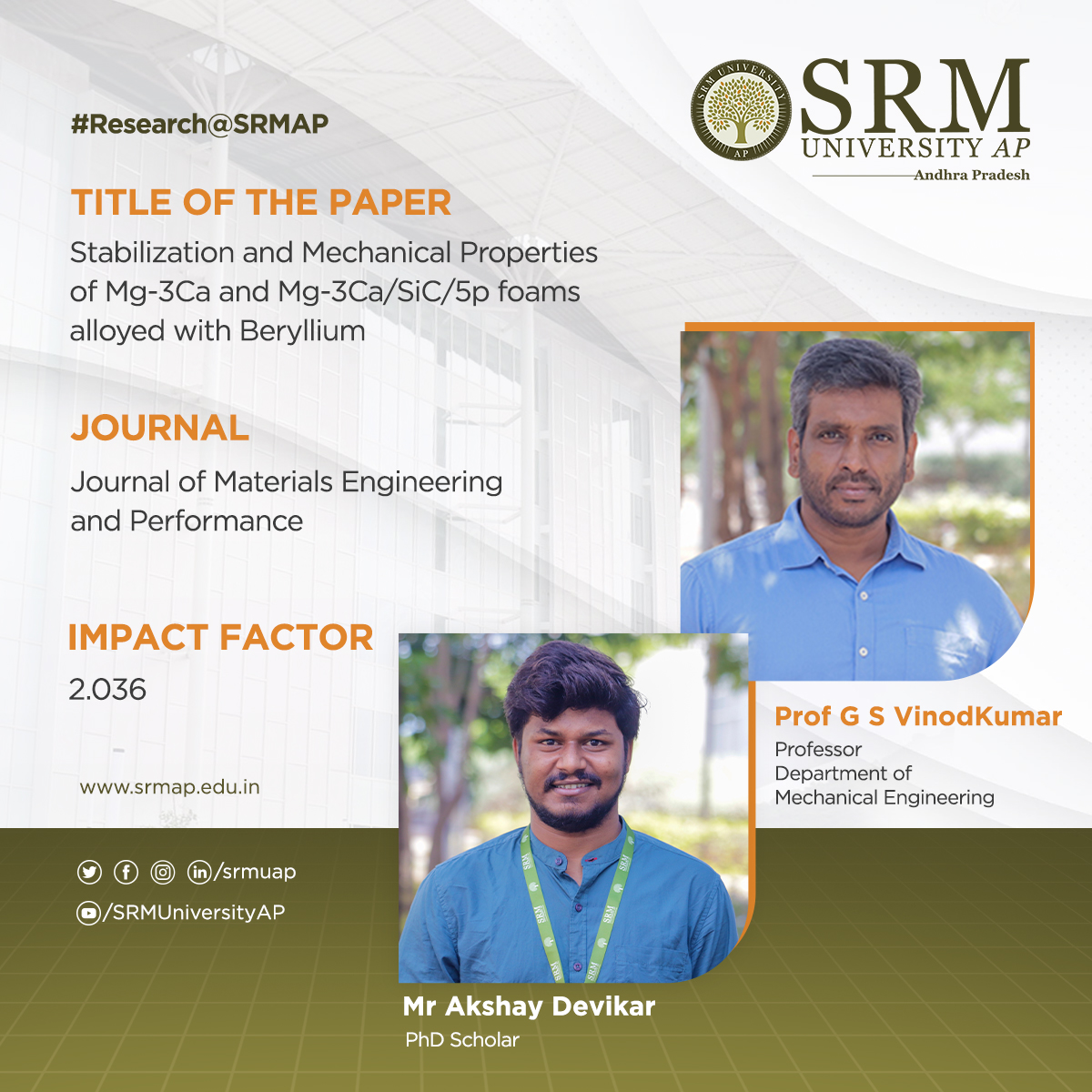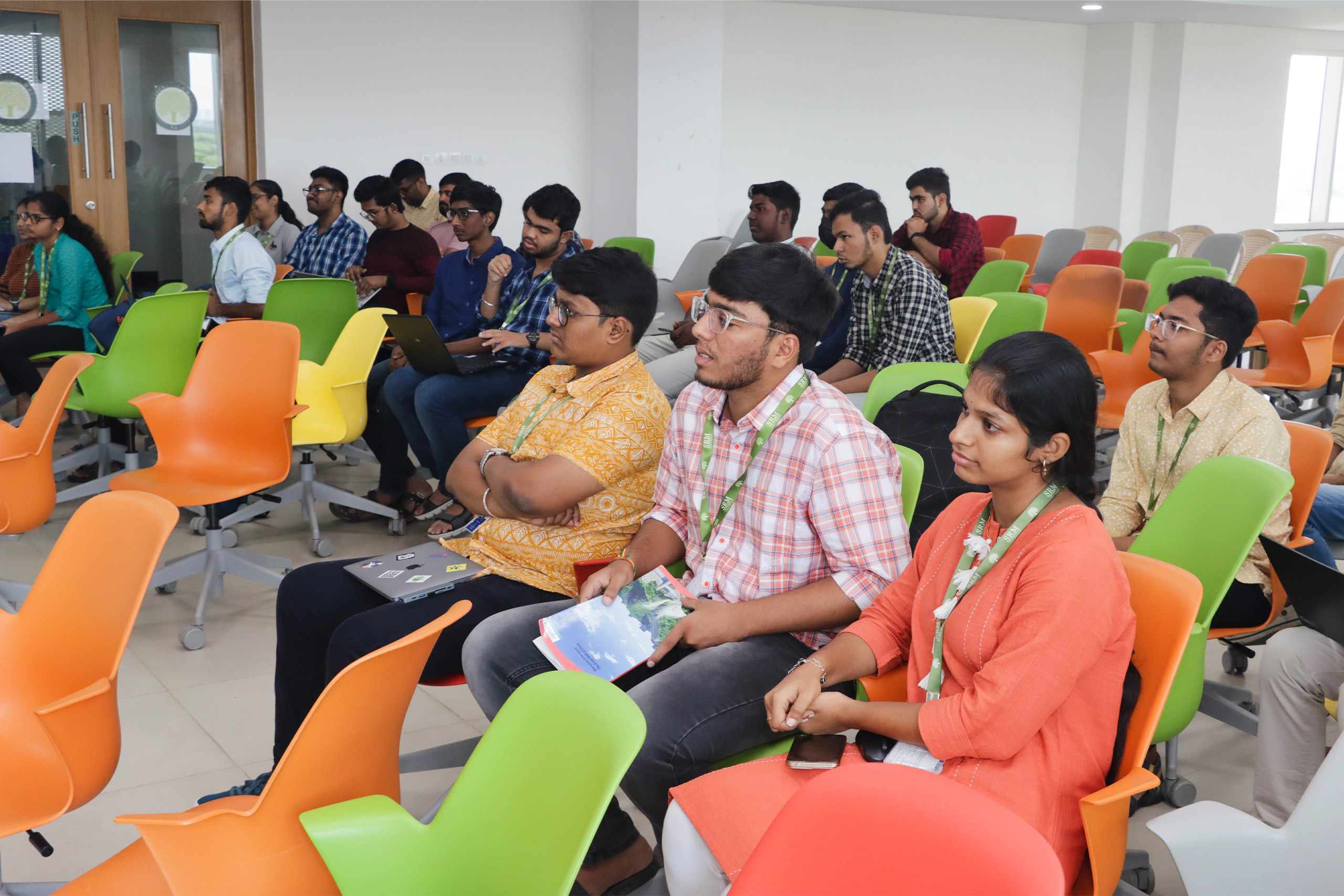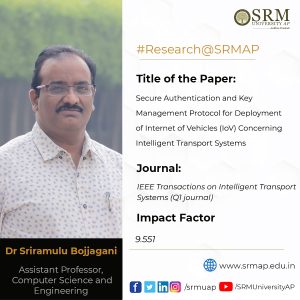An incredible journey to the India Book of Records

It is a moment of immense pride for SRM University- AP to welcome a new record maker into our midst. P Vishnu Vardhan from the Department of Computer Science Engineering has carved his name into the India Book of Records for performing 48 double-under jump rope skips in 20 seconds. He has also managed to set two records in the National Book of World Records. When most surrender their favourite hobbies to the rush of our work and academic life, this incredible student has displayed hardwork and dedication to transform his hobby into a national record.
Mr Vishnu Vardhan comments on the multiple times he succumbed to giving up his hobby of skipping ropes but realised that it was a space of refuge amidst the pressures of the world. He has shown an incredible feat of courage and dedication to set this impressive record by braving the rejection that he initially had faced.
“When I came to know about the India Book of Records, it was my parents who made me apply for it but I was rejected the first time. I had lost all hope but my friends supported me to pursue my passion for skipping rope and also helped with my academics. Finally I have entered into the National Book of Records, twice and the India Book of Records as well”, he said.
He has extended a heartfelt note towards his parents and his friends, M Surya Teja and K Nithin, for their undying support and confidence that has guided him to attain this amazing achievement.
Mr Vishnu Vardhan hopes to represent SRM University- AP at the All India Inter University rope skipping competition and provide further laurels for the institution. His journey to setting national records proves that with passion, endurance and a generous amount of optimism, even the unachievable could be achieved.
- Published in CSE NEWS, Departmental News, News, Sports News, Students Achievements
Two paper publications from Prof G S Vinod Kumar and his scholar
A robust body of published works helps advance research capabilities and contribute to the larger research domain. Two latest paper publications from the Department of Mechanical Engineering are co-authored by Prof G S Vinod Kumar and his PhD student, Mr Akshay Devikar.
 The first paper, Stabilization and Mechanical Properties of Mg-3Ca and Mg-3Ca/SiC/5p foams alloyed with Beryllium, got published in the Journal of Materials Engineering and Performance and had an impact factor of 2.036.
The first paper, Stabilization and Mechanical Properties of Mg-3Ca and Mg-3Ca/SiC/5p foams alloyed with Beryllium, got published in the Journal of Materials Engineering and Performance and had an impact factor of 2.036.
Liquid processing of Magnesium is complicated due to its uncontrolled flammability in the presence of oxygen. However, owing to the lightweight property of Mg, it can be used as a structural material in various sectors such as naval, aerospace, automobile, biomedical, heat exchangers, and military applications. Therefore, using Ca and Be as alloying elements and oxidation preventers, the researchers produced lightweight Mg foams (of density 0.17 g/cm 3), which float on water. SiC particles provide excellent Mg foam stabilisation as well. The compression tests revealed the highest strength for Mg-3Ca foam containing both Be and SiC. Thus, the burning problem of Mg was overcome by adding Ca and a trace quantity of Be to make lightweight foams, which were strengthened by SiC particles.
Abstract
The present paper investigates the stabilisation of Mg-3Ca alloy and Mg-3Ca/SiC/5p composite foams with and without the addition of 0.12 wt.% beryllium. In Mg-3Ca alloy foam, Be addition has significantly improved the expansion and pore structure. Whereas, in the case of Mg-3Ca/SiC/5p composite foams, the SiC particles stabilised the foam effectively, while Be addition did not show any distinguishable improvement in the foam structure. The formation of BeO and the dense coverage of SiC particles in the gas-solid interface of Mg-3Ca and Mg-3Ca/SiC/5p composite foams, respectively, are the reasons for the foam stabilization. Mg-3Ca/SiC/5p composite foam exhibited the lowest foam density of 0.10 g/cm3. The quasi-static compression test shows that Mg-3Ca-0.12Be/SiC/5p composite foam containing Be exhibited lower foam density and higher normalized compressive strength. The energy absorption capacity per unit foam density in Be containing foams was also higher.
 The second paper, the Effect of Beryllium on the stabilization of Mg-3Ca alloy foams, is published in the journal Materials Science and Engineering B with an impact factor of 3.407.
The second paper, the Effect of Beryllium on the stabilization of Mg-3Ca alloy foams, is published in the journal Materials Science and Engineering B with an impact factor of 3.407.
Mg-3Ca alloy foams of density as low as 0.25 g/cm3 were successfully produced via the liquid metal route in an open-air atmosphere with trace Be addition. The stable BeO layer formed at the gas-solid interfaces of pores restricted the Mg + CO2/CO reaction, thereby reducing the gas loss responsible for foaming. Be addition (0.13 wt.%) resulted in a high-volume expansion of Mg-3Ca foam (694 %). Metallic single films also exhibited smooth and crack-free interfaces with Be addition.
Abstract
The present work is the first-ever study where the influence of beryllium (Be) addition on the stability of Mg alloy foam was investigated. Mg-3Ca alloy foams were produced by the liquid processing route with and without Be micro-addition. CaCO3 was used as a blowing agent. Mg-3Ca alloy foam without Be resulted in stable foam but exhibited low expansion with poor foam structure. Be addition significantly increased foam expansion and improved their structure. The expansion and the structure of the Mg foams obtained are comparable with that of commercially available aluminum foams. The XPS analysis confirmed the presence of BeO at the gas-solid interface of Mg foam. Be stabilizes the gas-solid interface of the foam by forming a smooth and crack-free surface of the BeO layer, which prevents the continuous oxidation of liquid foam and minimises the loss of blowing gas, thereby enhancing the stability of Mg-3Ca alloy foams.
Bulletproof vests, Car body parts, Hip and Knee implants, Sound and heat-proof walls in theatres, Naval ship bodies, etc., are some of the applications of the research findings. The researchers have collaborated with Dr Manas Mukherjee (Associate Professor) and his PhD student, Mr Biswaranjan Muduli of the Department of Metallurgical and Materials Engineering, Indian Institute of Technology Madras, Chennai, for this work. Stabilisation using other alloying elements and ceramic particles for improving mechanical properties of Mg foams specific to application requirements and establishing structure-property relationship from the point of view of melt viscosity by altering the foaming parameters are the future plans of the research team.
- Published in Departmental News, Mechanical Engineering NEWS, News, Research News
15 Lakh investment for Manideep’s Hatchlab venture SPOCSQ Pvt
 Making an impact on society through revolutionary innovations is not an everyday thing. Manideep Surusomayajula from the Department of Computer Science and Engineering bagged an investment of 15 Lakh for his Hatchlab venture SPOCSQ Pvt. This is the first investment that has been secured by the startup project.
Making an impact on society through revolutionary innovations is not an everyday thing. Manideep Surusomayajula from the Department of Computer Science and Engineering bagged an investment of 15 Lakh for his Hatchlab venture SPOCSQ Pvt. This is the first investment that has been secured by the startup project.
His startup deals with chip-based certification processes using Blockchain Technology. SPOCSQ is in the process of developing a tamper-proof certificate system based on chip and blockchain technology.
The investing company ThredzIT Information Technology Pvt. Ltd is willing to invest 20-30 Lakh for the final version of the product. This achievement is a milestone in Manideep’s career as it demonstrates his passion for entrepreneurship and innovation.
- Published in CSE NEWS, Departmental News, IDEA NEWS, News, Students Achievements
In-situ Al–5ZrB2 composite foams : Comparable alternative for conventional Al foams

Closed-cell metal foams are crucial to heavy industry machinery as they primarily function as impact-absorbing materials. Stabilizing closed-cell metal foams is a pivotal element in the process of manufacturing closed-cell metal foams. On this note, Prof GS Vinod Kumar from The Department of Mechanical Engineering has published a paper entitled Production, stability, and properties of in-situ Al–5ZrB2 composite foams in the journal Materials Science and Engineering: A with an impact factor of 6.044.
Abstract
Stabilization is an essential requirement to produce closed-cell metal foams. In the melt route of foaming, usually ceramic particles are used as foam stabilizers. For the first time, the present study introduces ZrB2 particles as foam stabilizers. We demonstrate the foaming of in-situ based Al composite containing submicron ZrB2 particles. The effect of foaming temperature and holding time on the structural and mechanical properties of the foams was studied. The composites and foams were characterized using XRD, SEM/EDS, and optical scanning techniques. The mechanical properties of the foams were determined by subjecting the foams to a quasi-static compression test. Submicron ZrB2 particles present in the cell wall and at the gas-solid interface promoted foam stability. All the foams exhibited a good cellular structure with high expansion. Among the foams, the foams prepared at 680 ºC with a holding time of 120 s exhibited the smallest cell size and the best mechanical properties. The structural and mechanical properties of the Al–5ZrB2 foams were found to be comparable to conventional foams.
Novel in-situ ZrB2 particles were produced to form Al-5ZrB2 composites. ZrB2 particles present in the melt tend to stabilize the H2 gas bubbles produced from the decomposition of TiH2. The macrostructure was best observed when foamed at 680 ºC and held for 120 sec. Because of its finer pores ( ̴ 3mm ), excellent compressive strength and energy absorption capacity was exhibited comparable to conventional Al foams.
The paper observes a wide-range of possibilities for the application of in-situ Al–5ZrB2 composite foams to modify bullet proof vests, car body parts, sound and heat proof walls in theatres, naval ship bodies, etc.
Prof Vinod Kumar also discusses the future application of this technique in use of metallic powders as blending agent for effective dispersion of blowing agent in the melt and in the field of compressive and energy absorption studies for Al composite foams.
- Published in Departmental News, Mechanical Engineering NEWS, News, Research News
Tunnel Field Effect Transistor Design and Analysis for Biosensing Applications

The Department of Electronics and Communication Engineering is glad to announce that Mr Garikapati Anith Chowdary, a BTech passed-out student has published a paper in collaboration with Assistant Professor Dr M Durga Prakash. The paper titled Tunnel Field Effect Transistor Design and Analysis for Biosensing Applications was published in the Q2 journal Silicon having an Impact Factor 2.941.
The physical modelling of the tunnel field effect transistor (TFET) is done in this study. The Silvaco TCAD tool is used to design and simulate the TFET structure. The FET device has attracted a lot of attention as the ideal tool for creating biosensors because of its appealing properties such as ultra-sensitivity, selectivity, low cost, and real-time detection capabilities in a sensing point of view.
These devices have a lot of potential as a platform for detecting biomolecules. Short channel effects, specificity, and nano-cavity filling have all been improved in FET-based biosensors. FET-based biosensors are appropriate for label-free applications. Random dopant variations and a thermal budget are seen during the construction of a JLFET. To overcome this problem, the charge-plasma-based concept was established in FETs in this study.
Different metallurgical functions for electrodes were employed in this biosensor to behave as a p-type source and n-type drain. To alleviate the short channel effects, a dual material gate work function for the gate electrode was devised, as well as a double gate architecture. Biomolecules can be neutral or charge-based, and both types of biomolecules can be identified using a proof-of-concept FET-based biosensor. Changes in the drain current (Id) of the device were achieved by varying dielectric values and charges in the cavity region with variable cavity lengths.
- Published in Departmental News, ECE NEWS, News, Research News
Pitch 101: Incubating innovatory startup solutions

The Entrepreneurial Innovation Lab (ENNOVAB) at SRM University-AP has been the vanguard of student entrepreneurship and innovation. They have been organising inspiring sessions like Enrio, Ennote, Pitch 101, etc, to promote students in their entrepreneurial ventures.
In the recent session of Pitch 101, brought forth on October 12, 2022, students, and faculty of SRM University-AP came together to share their ideas and thoughts on launching revolutionary startups. The event was conceived to invite interesting startup ideas across various technical and non-technical domains, such as Fintech, IoT, Telecom and Media, Banking, Insurance, etc. Excellent ideas were rewarded with exciting prizes.
“Entrepreneurship is a culture, and we are here to support your dreams and ideas”, affirmed Prof B V Babu, Dean – School of Engineering and Sciences, inaugurating the session. Associate Director – Entrepreneurship Mr Udayan Bakshi encouraged students to grow from being job seekers to job providers. Associate Dean-in-Charge (Engineering) – School of Engineering and Sciences Prof T Ragunathan, and Assistant Professor Dr Dinesh Reddy were also present on the occasion.
Pitch 101 was introduced to instigate ennovab sessions that may serve as a one-stop solution to learn and experience ideas and plans and help know the specifics of entrepreneurship and building a startup.
- Published in Departmental News, Innovation, News, Student Startups
A champion in the making!

Mastering martial arts is not an easy feat as it demands an exorbitant amount of effort from our physical as well as mental capability. Truly excelling in a martial art form can only be achieved through the manifestation of hardwork, perseverance and unwavering willpower. The Department of Computer Science and Engineering is proud to announce that Ms Bala Ramya Sri Yerramreddy has been selected for the Wushu Championship at the 36th National Games, 2022.
Ms Bala Ramya had previously secured gold at both District and State Level Wushu competitions. Through her journey, she has exhibited strong willpower and dedication to reach these heights. She encourages students to pursue any field of sports or martial arts to attain a peaceful mental constitution as well as physical well-being. Martial arts also equips one with self-defence techniques against physical conflict.
Wushu, an ancient form of hard and soft Chinese martial arts, trains students with superior combat skills for self-defence and promotes sound mental and physical health. One is truly robust only with a healthy balance between well-tuned mind and body.
Her journey to the National Games 2022 representing the state of Andhra Pradesh is awe inspiring and an accomplishment of incredible pride.
- Published in CSE NEWS, Departmental News, News, Sports News, Students Achievements
Youth empowerment and skill development programme concluded

The Department of Computer Science and Engineering at SRM University-AP commenced a one-month-long programme on “Youth Empowerment and Skill Development”. The programme, organised under the ISR activities of the university, was an exclusive initiative for young people living in vicinal rural communities. The sessions aimed to enhance and develop their technical and computing skills to augment their possibilities for a better livelihood.
90 youths were given training on programmes and applications like Microsoft office and Frontend Tools for Web Development. The programme received an overwhelming response from around fifteen neighbouring villages. The young community from the villages; Mangalagiri, Pedavadlapudi, Kaza, Neerukonda, Lemalle, Navuluru, Kuragallu, Velagapudi, Nekkallu, Chiraravuru, Kanteru, Pedaparimi, Yerrabalem, Mandadam, and Sibiram; participated in the training programme.
Assistant Professors of the Department of Computer Science and Engineering, Dr Dinesh Reddy and Dr Mahesh Kumar, were the chief resource persons for the programme. Classes were held from August 29, 2022, to September 28, 2022, at the university premises. The valedictory function was conducted on October 13, and certificates were issued to the participants who had successfully completed the programme. Prof Manoj K Arora, Vice-Chancellor and Prof T Ragunathan, Associate Dean-in-Charge (Engineering) – School of Engineering and Sciences, were also present on the occasion.
- Published in CSE NEWS, Departmental News, News
Study on C and N dynamics in response to climate change
 Tropical forests are the breathing lungs of the world that work as a collective to stabilise climate by absorbing vast amounts of carbon dioxide. Covering over 12% of Earth’s total land surface. It functions as a harbour for evolution and supplying prerequisite rainfall for healthy vegetation. Recent global climate changes have catalysed drastic effects on the tropical forests and the healthy functioning of the same. A critical understanding of the present state of forest ecosystems is crucial for undertaking necessary measures to prevent further degradation.
Tropical forests are the breathing lungs of the world that work as a collective to stabilise climate by absorbing vast amounts of carbon dioxide. Covering over 12% of Earth’s total land surface. It functions as a harbour for evolution and supplying prerequisite rainfall for healthy vegetation. Recent global climate changes have catalysed drastic effects on the tropical forests and the healthy functioning of the same. A critical understanding of the present state of forest ecosystems is crucial for undertaking necessary measures to prevent further degradation.
Recently, the project entitled Assessment and modelling of carbon and nitrogen dynamics in tropical forests of Eastern Ghats, Andhra Pradesh in response to climate change, has been sanctioned to Dr Javid Ahmad D, Assistant Professor, Department of Environmental Science by DST – SERB (Science and Engineering Research Board), Govt of India, with a total outlay of Rs. 28.54 lakhs. Dr Javid Ahmad D is the principal investigator of the project.
A complete dataset on long-term dynamics in vegetation, the C and N generated for different tropical forest types in the Eastern Ghats landscape would serve as a baseline data for forest managers and policy-makers. The project aims to gain insight on the response of these tropical forests to changing global climate in relation to multiple factors (elevated CO2, increased temperatures and altered precipitation).
- Published in Departmental News, ENVS News, News, Research News
AKAP-IoV: Facilitating an intelligent transportation infrastructure
 Intelligent transport systems embedded with latest technology is the future of automotive industry and can revolutionise the very infrastructure and architecture of transportation. The principles of intelligent transportation systems have manifested in the development of Internet of vehicles (IoV), a novel technological network that enables autonomous and connected mobile commutation facility. Dr Sriramulu Bojjagani, Assistant Professor, Department of Computer Science and Engineering, has published a paper on this seminal topic titled “Secure Authentication and Key Management Protocol for Deployment of Internet of Vehicles (IoV) Concerning Intelligent Transport Systems” in the prestigious journal, IEEE Transactions on Intelligent Transport Systems (Q1 journal) having an Impact factor of 9.551. The paper highlights the development and significance of the pioneering AKAP-IoV system in successfully tackling cyber threats and security vulnerabilities.
Intelligent transport systems embedded with latest technology is the future of automotive industry and can revolutionise the very infrastructure and architecture of transportation. The principles of intelligent transportation systems have manifested in the development of Internet of vehicles (IoV), a novel technological network that enables autonomous and connected mobile commutation facility. Dr Sriramulu Bojjagani, Assistant Professor, Department of Computer Science and Engineering, has published a paper on this seminal topic titled “Secure Authentication and Key Management Protocol for Deployment of Internet of Vehicles (IoV) Concerning Intelligent Transport Systems” in the prestigious journal, IEEE Transactions on Intelligent Transport Systems (Q1 journal) having an Impact factor of 9.551. The paper highlights the development and significance of the pioneering AKAP-IoV system in successfully tackling cyber threats and security vulnerabilities.
Abstract
Intelligent transport systems amalgamated with advanced technologies are an important element of the automotive industry, including critical infrastructure and transportation. Internet of Vehicles (IoV) is the modern technological framework designed for intelligent transportation. IoV creates a network of information relations among vehicles, thus contributing to reduced congestion, roadside infrastructure, driver/traveller safety, and traffic efficiency through wireless communication and sensing technology. However, a significant challenge in IoV applications is security, as criminals could potentially exploit these applications. Despite increasing industry awareness, the potential danger posed by security vulnerabilities and cyber threats remains high. In this study, we have designed a new system called AKAP-IoV, which supports secure communication, mutual authentication, and key management among vehicles, roadside units, and fog and cloud servers. AKAP-IoV was tested and verified using Scyther and Tamarin to ensure its resistance to cyber threats. Furthermore, we conducted a formal security analysis using the Real-or-Random (RoR) oracle model to assess security properties logically. In addition, a detailed, comprehensive comparative study was considered to evaluate the performance, functionality, efficiency, and security features supported by AKAP-IoV compared to those of recently developed schemes.
- Published in CSE NEWS, Departmental News, News, Research News







